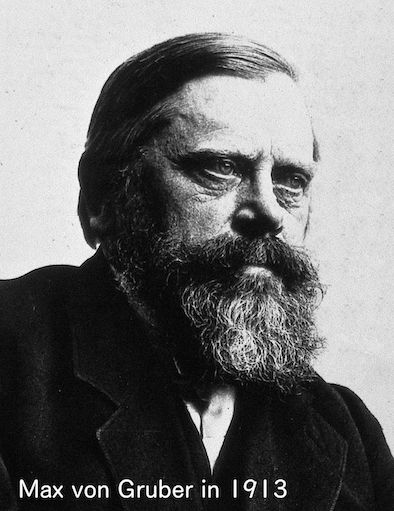マックス・フォン・グルーバー
Max von Gruber, 1853-1927

マックス・フォン・グルーバー
Max von Gruber, 1853-1927

ここに概要を書く(→★ いるか08モダン)
| Max von Gruber
(6 July 1853, in Vienna – 16 September 1927, in Berchtesgaden) was an
Austrian scientist. As a bacteriologist he discovered specific
agglutination in 1896 with his English colleague Herbert Durham
(Gruber-Widal-reaction). But his main interests were studying hygiene
and sexual life. |
マッ
クス・フォン・グルーバー(1853年7月6日、ウィーン -
1927年9月16日、ベルヒテスガーデン)は、オーストリアの科学者である。細菌学者として、1896年にイギリスの同僚ハーバート・ダラムと特異的凝
集反応を発見した(グルーバー・ワイダル反応)。しかし、彼の主な関心は衛生学と性生活の研究であった。 |
| Max
von Gruber was the son of Ignaz Gruber (1803–1872), a general
practitioner and the first specialist in otology in Austria, and
publisher of a two-volume textbook on medical chemistry (1835). His
brother was Franz von Gruber. He graduated from the Schottengymnasium
in Vienna and studied medicine at the University of Vienna, receiving
his medical doctorate in 1876. He then learned chemistry and physiology
under Max von Pettenkofer (1818–1901) and Karl von Voit (1831–1908) in
Munich and Karl Ludwig (1816–1895) in Leipzig. Also working under
Pettenkofer was Hans Ernst August Buchner (1850–1902), who encouraged
Gruber to concentrate on bacteriology. Unlike some of the great names of the time, among them Carl Wilhelm Nägeli, Theodor Billroth (1829–1894), Ferdinand Cohn (1828–1898), and Robert Koch (1843–1910), Gruber recognized that bacteria possess a variability within limits partially determined by the culture medium. This theory was important for the differentiation of the categories of bacteria and gained significance for Gruber in his examinations of cholera vibrios, enabling him to distinguish them from other vibrios. |
マッ
クス・フォン・グルーバーは、開業医でオーストリア初の耳鼻科専門医であり、医学化学の教科書2巻(1835年)を出版したイグナツ・グルーバー
(1803-1872)の息子であった。兄はフランツ・フォン・グルーバー。ウィーンのショッテンギムナジウムを卒業し、ウィーン大学で医学を学び、
1876年に医学博士号を取得した。その後、ミュンヘンのマックス・フォン・ペッテンコーファー(1818-1901)とカール・フォン・ヴォイト
(1831-1908)、ライプツィヒのカール・ルドウィッグ(1816-1895)の下で化学と生理学を学ぶ。ペッテンコーファーの下には、ハンス・エ
ルンスト・アウグスト・ブフナー(1850-1902)もいて、彼はグルーバーに細菌学に集中するように勧めた。 当時、カール・ヴィルヘルム・ネーゲリ、テオドール・ビルロート(1829-1894)、フェルディナンド・コーン(1828-1898)、ロベルト・ コッホ(1843-1910)らと違って、グルーバーはバクテリアが培地によって部分的に決まる範囲内で変動することを認めている。この理論は、細菌のカ テゴリーを区別する上で重要であり、グルーバーはコレラ菌の検査において、他のビブリオ菌との区別を可能にし、重要な意味を持つようになった。 |
| In
1882 Gruber was habilitated as a lecturer in Vienna, and two years
later he became associate professor and head of the newly established
Institute for Hygiene at the University of Graz. On 23 March 1887 he
became ausserordentlicher professor in Vienna, succeeding Josef Nowak,
and on 10 December 1891 he was appointed to the chair of hygiene
established in 1875 at the University of Vienna. Karl Landsteiner
became his assistant in 1896. Another of his pupils, Alois Lode, in
1897 became the first professor in the new chair of hygiene at the
University of Innsbruck. The working conditions in the Institute of
Hygiene were so poor, that Gruber attempted to resign his chair and
find employment as head of a laboratory in München or at the Jenner
Institute in London, under Joseph Lister. It was while in Vienna,
however, that Gruber, with his English student Herbert Edward Durham
(1866–1945), discovered the agglutination which gained him
international fame. Gruber eventually left Vienna in 1902, and in October that year he succeeded Hans Buchner as director of the Institute for Hygiene in München. He held the post until his voluntary retirement in 1923, on the occasion of his seventieth birthday. In Vienna he was succeeded by Arthur Schattenfroh (1869–1923), who held the chair from 1905 to 1923. |
1882
年、グルーバーはウィーンで講師となり、2年後にはグラーツ大学に新設された衛生学研究所の助教授と所長になった。1887年3月23日には、ヨーゼフ・
ノヴァックの後任としてウィーンのアウサーロデントリヒャー教授となり、1891年12月10日には、1875年にウィーン大学に設置された衛生学の講座
に任命されることになった。1896年にはカール・ラントシュタイナーが彼の助手となった。1897年には、彼の弟子の一人であるアロイス・ローデが、イ
ンスブルック大学の新しい衛生学講座の最初の教授となった。衛生学研究所の労働条件は非常に悪く、グルーバーは教授を辞め、ミュンヘンの研究所かロンドン
のジェンナー研究所で、ジョセフ・リスターのもとで働こうとした。しかし、グルーバーはウィーンに滞在中、イギリス人学生ハーバート・エドワード・ダーラ
ム(1866-1945)と共に、世界的に有名になった凝集素を発見したのであった。 1902年、グルーバーはウィーンを離れ、同年10月にハンス・ブフナーの後任としてミュンヘンの衛生研究所の所長に就任した。1923年、70歳の誕生 日に自ら引退するまでその職を務めた。ウィーンでは、アルトゥール・シャッテンフロー(1869-1923)が後を継ぎ、1905年から1923年までそ の地位を保持した。 |
| During his last years, Gruber concentrated completely on his duties as president of the Bavarian Academy of Sciences. With Max Rubner and P. Martin Ficker (1868–) he published the Handbuch der Hygiene. 6 volumes; Leipzig, S. Hirtzel, 1911–1913. As a leading racial hygienist, when he first met the Nazi dictator Adolf Hitler he described him as: It was the first time I had seen Hitler close at hand. Face and head of inferior type, cross-breed; low receding forehead, ugly nose, broad cheekbones, little eyes, dark hair. Expression not of a man exercising authority in perfect self-command, but of raving excitement. At the end an expression of satisfied egotism. — Description as a witness at court in 1923[1] https://en.wikipedia.org/wiki/Max_von_Gruber |
晩年、グルーバーはバイエルン科学アカデミーの会長としての職務に完全に集中した。 マックス・ルブナー、P.マーティン・フィッカー(1868-)とともに『衛生学ハンドブック』を出版した。6巻; Leipzig, S. Hirtzel, 1911-1913年。 人種衛生学の第一人者として、ナチスの独裁者アドルフ・ヒトラーに初めて会った時、彼はこう表現している。 ヒトラーを間近に見たのは初めてだった。顔や頭は劣等種、交雑種で、低く後退した額、醜い鼻、広い頬骨、小さな目、黒い髪。その表情は、完璧な自己統制のもとに権威を行使しているのではなく、狂喜乱舞しているのだ。最後には満足したエゴイズムの表情をしている。 - 1923年、法廷での証人としての記述[1]。 |
+++
Links
リンク
文献
その他の情報


